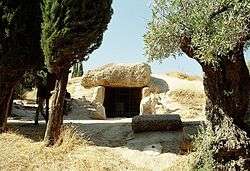Dolmen of Menga
| Dolmen of Menga | |
|---|---|
|
Dolmen of Menga entrance | |
| Coordinates | 37°01′28.51″N 4°32′46.65″W / 37.0245861°N 4.5462917°WCoordinates: 37°01′28.51″N 4°32′46.65″W / 37.0245861°N 4.5462917°W |
| Official name: Antequera Dolmens Site | |
| Type | Cultural |
| Criteria | i, iii, iv |
| Designated | 2016 (40th session) |
| Reference no. | 1501 |
| State Party | Spain |
| Region | Europe and North America |
The Dolmen of Menga (Spanish: Dolmen de Menga) is a megalithic burial mound called a tumulus, a long barrow form of dolmen, dating from the 3rd millennium BCE. It is near Antequera, Málaga, Spain.
It is one of the largest known ancient megalithic structures in Europe.[1][2] It is 25 metres (82 ft) long, 5 metres (16 ft) wide and 4 metres (13 ft) high, and was built with thirty-two megaliths, the largest weighing about 180 tonnes (200 tons). After completion of the chamber (which probably served as a grave for the ruling families) and the path leading into the center, the stone structure was covered with soil and built up into the hill that can be seen today. When the grave was opened and examined in the 19th century, archaeologists found the skeletons of several hundred people inside.
The dolmen sits 70 metres (230 ft) from the Dolmen de Viera[3] and about 4 kilometres (2.5 mi) from another subterranean structure known as Tholos de El Romeral.[4]
In 2016, the dolmens of Menga, Viera, and El Romeral were all inscribed as a UNESCO World Heritage Site under the name "Antequera Dolmens Site".
See also
References
| Wikimedia Commons has media related to Dolmen of Menga. |
- ↑ "Antequera Dolmen Sites". Unesco.org. UNESCO. January 27, 2012. Archived from the original on September 5, 2015.
- ↑ Journal for the History of Astronomy. Science History Publications. 1994. p. 556.
- ↑ Dólmenes de Antequera, nuevaacropolismalaga.org. Accessed online 2010-01-23.
- ↑ Conjunto Arqueológico Dólmenes de Antequera, Consejería de Cultura, Junta de Andalucía. Accessed online 2010-01-23.
